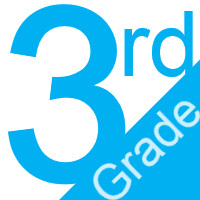3rd Grade English
 Standards Glossaries
Standards Glossaries
| K Grade English | 1st Grade English | 2nd Grade English |
 Standards Glossaries
Standards Glossaries
| 3rd Grade English | 4th Grade English | 5th Grade English |
 Standards Glossaries
Standards Glossaries
| 6th Grade English | 7th Grade English | 8th Grade English |
 Standards Glossaries
Standards Glossaries
| 9th Grade English | 10th Grade English | 11th Grade English | 12th Grade English |
 Standards Glossaries
Standards Glossaries
| HS Journalism | HS Speech |
| (RF) Reading Foundations |
ELA-03.RFNarrative for the Reading Foundations Strand:The foundational skill standards are directed toward fostering students’ understanding and working knowledge of concepts of print, the alphabetic principle, and other basic conventions of the English writing system. These foundational skills are not an end in and of themselves; rather, they are necessary and important components of an effective, comprehensive reading program designed to develop proficient readers with the capacity to comprehend texts across a range of types and disciplines. Phonics: In third grade students work on developing strategies that enable them to decode multi-syllable words and irregularly spelled words. Third graders also learn to identify words with affixes (prefixes and suffixes) and learn that affixes have meanings and can change the meanings of words to which they are attached. Third grade students learn to recognize common prefixes and inflectional and derivational suffixes and can explain how these common prefixes and suffixes change the meaning of a word. For example, they can explain that the prefix –un means not in the word unhappy. Fluency: Fluency is defined as being able to read orally with a reasonable rate of speed, with a high degree of accuracy, and with the proper expression (prosody). Fluency is one of several critical factors necessary for reading comprehension.
How to help my child at home with the Foundational Skill Standards:
Resources
Calculation Method for StrandsStrands are larger groups of related standards. The Strand Grade is a calculation of all the related standards. Click on the standard name below each strand to access the learning targets and proficiency scales for each strand's related standards. | |
ELA-03.RF.04ELA-04.RF.04 Read with sufficient accuracy and fluency to support comprehension.Sub-Standards:
a. Read grade level text with purpose and understanding.
b. Read grade level text orally with accuracy, appropriate rate, and expression on successive readings.
c. Use context to confirm or self-correct word recognition and understanding, rereading as necessary.
| |



 Grade 3
Grade 3